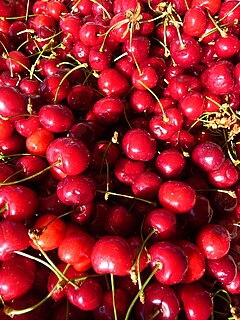
A cherry is the fruit of many plants of the genus Prunus, and is a fleshy drupe.

A plum is a fruit of some species in Prunus subg. Prunus. Mature plum fruits may have a dusty-white waxy coating that gives them a glaucous appearance. This is an epicuticular wax coating and is known as "wax bloom". Dried plums are called prunes, which have a dark, wrinkled appearance.

The rambutan is a medium-sized tropical tree in the family Sapindaceae. The name also refers to the edible fruit produced by this tree. The rambutan is native to Southeast Asia. It is closely related to several other edible tropical fruits including the lychee, longan, pulasan and mamoncillo.

Fruit tree propagation is usually carried out vegetatively (non-sexually) by grafting or budding a desired variety onto a suitable rootstock.

The loquat is a large evergreen shrub or tree, grown commercially for its orange fruit and for its leaves for tea, and also cultivated as an ornamental plant.

Prunus virginiana, commonly called bitter-berry, chokecherry, Virginia bird cherry, and western chokecherry, is a species of bird cherry native to North America. The natural historic range of P. virginiana includes most of Canada, most of the United States, and northern Mexico.

Mirabelle plum, also known as mirabelle prune or cherry plum, is a cultivar group of plum trees of the genus Prunus. It is believed that the plum was cultivated from a wild fruit grown in Anatolia.

The Royal Ann or Royal Anne is a variety of cherry, similar in appearance and taste to the 'Rainier cherry'.
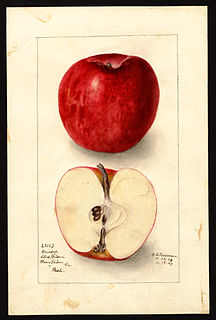
Winesap is an old apple cultivar of unknown origin, dating at least to American colonial times. Its apples are sweet with a tangy finish. They are used for eating, cooking, and cider.

Peonidin is an O-methylated anthocyanidin derived from Cyanidin, and a primary plant pigment. Peonidin gives purplish-red hues to flowers such as the peony, from which it takes its name, and roses. It is also present in some blue flowers, such as the morning glory.

Prunus necrotic ringspot virus (PNRSV) is a plant pathogenic virus causing ring spot diseases affecting species of the genus Prunus, as well as other species such as rose and hops. PNRSV is found worldwide due to easy transmission through plant propagation methods and infected seed. The virus is in the family Bromoviridae and genus Ilarvirus. Synonyms of PNRSV include European plum line pattern virus, hop B virus, hop C virus, plum line pattern virus, sour cherry necrotic ringspot virus, and peach ringspot virus.
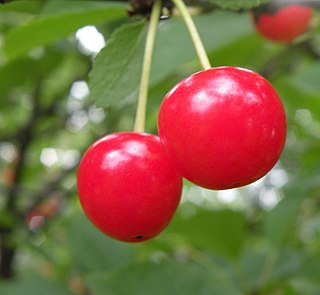
The Montmorency cherry is a variety of sour cherry grown in Europe, Canada, and the United States, particularly in the Grand Traverse Bay region of Northwest Michigan and in Door County, Wisconsin. Montmorency cherries are part of the lighter-red Amarelle cultivar of sour cherries, rather than the darker-red Morello cultivar. Michigan produces over 90,000 tons of Montmorency cherries each year.

The Emperor Francis cherry is a sweet cherry cultivar (Prunus avium) that produces a bright red fruit which is resistant to cracking. In 1996, it was the source of the first cherry genetic map, which was created from a haploid-microspore derived population from the 'Emperor Francis' cultivar. It is also one of the sources of the 'Newfane' sweet cherry, which was created by crossing the 'Emperor Francis' with the 'Stella' cherry. It can be cross-pollinated with 'Montmorency' cherry.
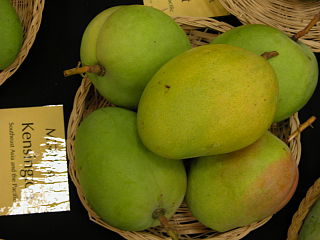
The 'Kensington Pride' mango is a named commercial mango cultivar that originated in Australia. It is sometimes called the KP, Bowen or Bowen special. It is Australia's most popular mango, accounting for over 80% of the country's annual commercial mango market. It is considered to have a distinctive flavour and aroma when compared with the Florida-bred cultivars grown by most mango-exporting countries.
Marsol is a natural chestnut hybrid, a cross between a European chestnut and Japanese.
Comballe is a French traditional chestnut variety. In France, it is the variety with the largest production. This beautiful rustic nut of Ardèche origin has a bright, streaky chestnut colour. Its fine, sweet and fragrant flesh justifies the excellent taste reputation.

Stella is a cultivar of cherry developed in British Columbia, Canada. It is notable as the first self-fertile sweet cherry to be named. It has been awarded the Royal Horticultural Society's Award of Garden Merit.
The Sweetheart cherry is a cultivar of cherry. It is a hybrid of the Van and Newstar cultivars first developed in Canada.
Skeena is a cultivar of cherry originating in Canada.
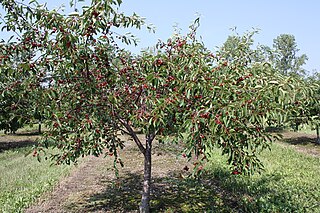
The Balaton cherry is a cultivar of sour cherry native to Hungary, where it was originally named Újfehértói Fürtös. It was introduced to the United States in the 1980s and is now grown there commercially.

















